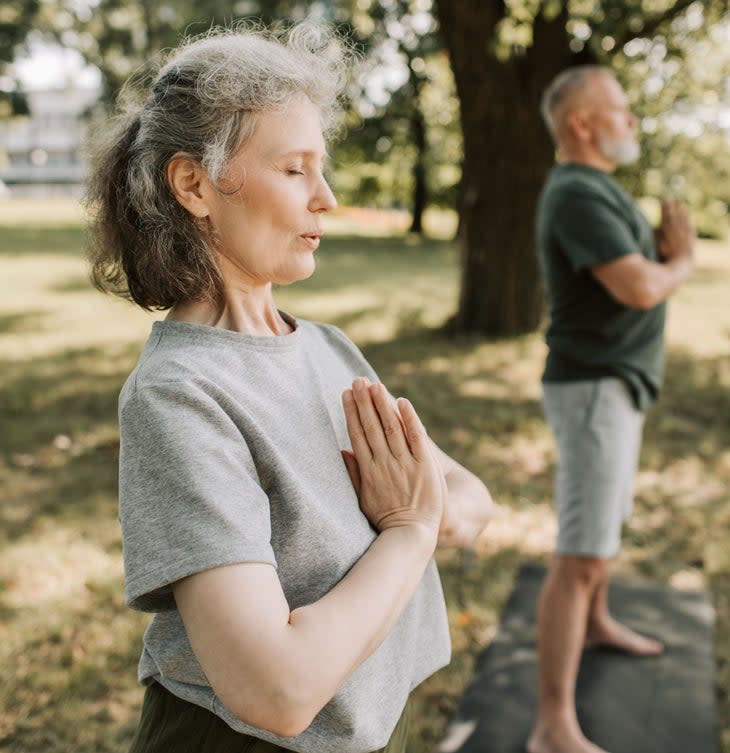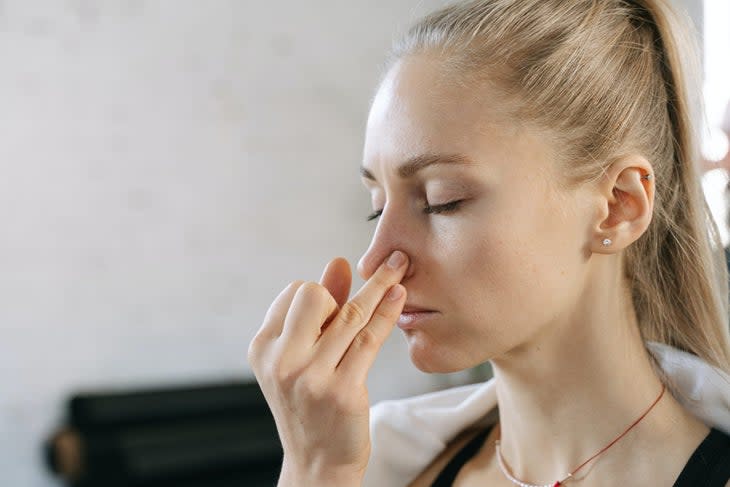What is Pranayama?
This article originally appeared on Yoga Journal
In yoga, as in life, breathing can be taken for granted. It’s something we do automatically, involuntarily, unconsciously. But our yoga ancestors understood that breath is life. This is why pranayama or yogic breathing, is sometimes referred to as the “heart of yoga.”
Pranayama is the fourth of the Eight Limbs of yoga, but is just as important as asana, or the physical postures. From ancient times, yoga practitioners believed that pranayama had the power to bring the body and elevate the mind and spirit. In recent years, contemporary science supports what ancient tradition has taught for centuries: awareness of the breath can directly affect the quality of your health and your life.
What is pranayama?
While we often simplify the term pranayama to mean “breathwork,” the yogic meaning of pranayama is a bit more nuanced.
First, it’s helpful to understand the origins of the word. In Sanskrit as well as yoga tradition, prana means “life force,” and describes the energy that sustains the life of the body. Indu Arora, in her book Yoga: Ancient Heritage, Tomorrow's Vision, breaks it down even further. "Pra means 'primary, first, innate.' Ana, from anu, means 'the tiniest, smallest, indestructible unit of energy."
The word pranayama is a combination of prana and ayama, which translates as "to extend, expand or draw out.” Some also say that the word is the combination of prana and yama, or "control." With either translation, you arrive at the same concept: pranayama is a practice that involves the management or control of the breath. As implied by the literal translation of pranayama, yogis believe that this practice not only rejuvenates the body but actually extends life itself.
This fourth limb of yoga consists of techniques designed to gain mastery over the respiratory process while recognizing the connection between the breath, the mind, and the emotions.
Pranayama is an integral part of the yogic tradition, but not always an easy one to grasp, according to yoga teacher Tony Briggs. “Pranayama is meant to nurture a high level of bodily health and mental clarity, both of which are crucial steps on the path to self-knowledge and a wholesome, authentic life,” he writes.

Practicing pranayama
You can do pranayama as a stand-alone practice: Sit or lie quietly as you experiment with the various breathing exercises. Or incorporate it into asana practice, coordinating your breath with your movements. You can also introduce pranayama into your daily activities-during physical exercise or exertion, in stressful situations, or to help you cope with health challenges such as insomnia.
You will find instructors teaching a wide range of pranayama techniques. Styles vary according to the discipline in which it is taught. Six of the traditions that practice specific pranayama styles include Integral Yoga (connecting movement with meditation), Kripalu (cultivating sensitivity and awareness), Ashtanga (unifying action, breath, and attention), Iyengar (developing precision, power, and subtlety), Viniyoga (creating a personalized practice), and Kundalini (combining mudra, mantra, and breath). You may find similarities and differences among these and other yoga traditions.
Benefits of Pranayama
The ancients believed that pranayama practice was a powerful tool for healing and for enhancing general vitality. Nadi Shodana, for example, has been practiced to synchronize the two hemispheres of the brain and purify the subtle energy channels (nadis) of the body so the prana flows more easily during pranayama practice. Viloma Pranayama is thought to calm the body and mind, reduce anxiety and tension, relax the nervous system, boost lung capacity, and energize and cool the body.
Research has begun to support this traditional wisdom. A 2018 study published in Frontiers in Human Neuroscience found that practicing a mindful, slow breathing (10 breaths per minute or fewer) was associated with "increased comfort, relaxation, pleasantness, vigor and alertness, and reduced symptoms of arousal, anxiety, depression, anger, and confusion." An engaged breath practice can help lower your heart rate and blood pressure, as well as relieve minor fatigue, according to medical research. When you practice pranayama, you may notice a change in your energy levels, the temperature of your body, or even your emotional state as you practice.
Pranayama for Mental Health
Pranayama can also reduce stress, anxiety, and depression. Controlled breathing impacts the parasympathetic nervous system. (Consider the fact that you may instinctively take slow, deep breaths when you’re trying to calm yourself in a stressful situation.)
“In stressful times, we typically breathe too rapidly,” writes pranayama expert Richard Rosen. “This leads to a buildup of oxygen in the bloodstream and a corresponding decrease in the relative amount of carbon dioxide, which in turn upsets the ideal acid-alkaline balance--the pH level--of the blood.”
This leads to a condition called respiratory alkalosis, which can result in muscle twitching, nausea, irritability, lightheadedness, confusion, and anxiety. But controlled, slowed breath raises carbon dioxide levels in the blood, pushing the pH level to a less alkaline state. “As the blood's pH changes, the parasympathetic nervous system calms us in a variety of ways, including telling the vagus nerve to secrete acetylcholine, a substance that lowers the heart rate.”

Pranayama exercises
Ancient yogis thought of the body-particularly the torso-as a container for our vital energy, Rosen explains in his book, The Yoga of Breath: A Step-by-Step Guide to Pranayama. The body must be prepared for pranayama, especially for techniques that involve holding the breath or breathing forcefully or vigorously, such as Kapalabhati. He suggests that asana practice helps strengthen the body for the physical aspects (and results) of the practice. Practicing the yamas and niyamas help with the necessary mental preparation.There are many different types of yogic breathing techniques-and many variations on how they are taught. Some of the more common ones that you might encounter in a yoga class are below.
Ujjayi Pranayama
Ujjayi pranayama or “victorious breath,” is one of the most common pranayama techniques-most often included with asana practice. It is practiced by gently constricting the opening of the throat to create some resistance to the passage of air. “Gently pulling the breath in on inhalation and gently pushing the breath out on exhalation against this resistance creates a well-modulated and soothing sound--something like the sound of ocean waves rolling in and out,” writes Ashtanga teacher Tim Miller. This is why you may sometimes hear it called “ocean breath.”
An easy way to get the feel of Ujjayi is to imagine fogging up a mirror. Exhale with an open mouth, feeling the breath moving across your throat and hearing that "ocean" sound. Once you are accustomed to the feeling in your throat, practice inhaling and exhaling with a closed mouth.
Ujjayi can be incorporated into asana practice: Use this technique whenever you inhale and exhale as you practice poses or sequences. It can also be a stand-alone practice or a part of your meditation practice if you sit quietly and focus on the breath. Briggs describes an Iyengar-style pranayama practice that involves lying in Savasana (Corpse Pose). “Let your body be still; let your nerves become quiet,” says Briggs. “In this stillness and quietness, simply observe the quality of your natural breath."
Sama Vritti Pranayama (Box Breathing)
Sama Vritti Pranayama is another powerful tool that can help clear your mind, relax your body, and allow you to focus.
Sit in a comfortable seat with your back supported and feet on the floor.
Close your eyes. Breathe in through your nose, slowly counting to 4. Feel the air filling your lungs.
Hold your breath and slowly count to 4 again. Try not to clamp your airways shut. Simply avoid inhaling or exhaling for 4 counts.
Slowly exhale to the count of 4.
Hold the exhale for another 4 counts.
Repeat this cycle or breath for 4 minutes or until you feel calm and centered.
Dirgha Pranayama
Dirgha pranayama is often called Three-Part Breath. It Involves briefly interrupting your inhalations and/or exhalations with pauses. It raises your awareness of your lung capacity and the structure of your torso.
Lie in a reclined position-either flat on your back or propped up by bolsters, blocks, blankets or a combination of these.
Inhale to a third of the lungs’ capacity, then pause for two to three seconds.
Inhale another third, pause again, and inhale until the lungs are filled.
Pause, then repeat the pattern on the exhale-exhaling the breath in thirds.
You may also practice pausing only on the inhalation, then releasing the full breath on one exhalation, or vice versa: take in one deep breath, then exhale in three parts.
Nadi Shodhana Pranayama
Alternate-nostril breathing is practiced to help calm the body and mind. It can regulate your nervous system by activating the body’s relaxation response.
Sit in a comfortable asana and make Vishnu Mudra with your right index and middle finger folded in to meet the base of your thumb and the other fingers extended. Your left hand can rest on your left thigh or in your lap. It can also be used to support your right elbow.Gently close your right nostril with your thumb. Inhale through your left nostril, then close it with your ring finger and pinky. After a very brief pause, open and exhale slowly through the right nostril.
Keep the right nostril open, inhale, then close it, and open and exhale slowly through the left. This is one cycle. Repeat 3 to 5 times, then release the hand mudra and go back to normal breathing.
Kapalabhati (Skull Shining Breath)
Kapalabhati, also sometimes called Skull Brightener, consists of alternating short, explosive exhales and slightly longer, passive inhales. Exhalations are generated by powerful contractions of the lower belly (between the pubis and navel), which push air out of the lungs. Inhalations are in response to the release of this contraction, which sucks air back into the lungs. You can begin to practice this technique in a seated position or a reclined position with your fingers placed lightly on your belly.
Focus on your lower belly. If needed, cup one hand lightly in the other and press them gently against your lower belly. (With practice you will have more abdominal control and hands may not be necessary.)
Now quickly contract your lower belly, pushing a burst of air out of your lungs. Then quickly release the contraction (or your hands), so the belly "rebounds" to suck air into your lungs. Pace yourself slowly at first.
Repeat eight to 10 times at about one exhale-inhale cycle every second or two. As you become more adept at contracting/releasing your lower belly, you can increase your pace to about two exhale-inhale cycles every second. Imagine the exhalation sweeping out or "brightening" the inner lining of your skull.
Do 25 to 30 cycles at first. Gradually increase the number of cycles you do each practice to 100 or more.
According to Rosen, kapalabhati is a preparation for the more intense Bhastrika or Bellows Breath.
For more information on these and other pranayama techniques including Deer Seal, Kumbhaka Pranayama, and Svara Yoga Pranayama, see Yoga Journal's Pose Finder.
This article has been updated. It was originally published on March 25, 2021.
For exclusive access to all of our fitness, gear, adventure, and travel stories, plus discounts on trips, events, and gear, sign up for Outside+ today.

